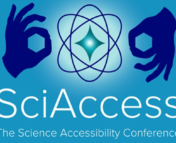Astrobite written by Sahil Hegde and Mark Popinchalk
The first moments of an eclipse are terrifying because all of a sudden the Sun is gone. A deep fear and unease sets in as that ever-present source of warmth and light is blocked, restricted, denied. What separates modern eclipse hunters from the millions of frightened humans who witnessed eclipses in the past, what makes that terror exhilarating for us today, is the fact that we now know the Sun will return in a few minutes. On April 8th, tens of millions of people will attempt to see the total solar eclipse, traveling, planning, and sharing the experience of witnessing the most powerful object in our solar system suddenly vanish. It is only because we know that we can and will see the Sun again—and whenever we want—that we can celebrate its disappearance.
But what if you didn’t have control of when you could see the Sun? For the over two million people incarcerated in the US alone and ten million worldwide, a view of the Sun is—at best—limited to what little can be seen of the sky during the day or through a barred window.
And what if, during this period of constraint there is a chance to see an eclipse? To feel the fear and exhilaration that comes with a serendipitous syzygy between the Earth, Moon, and Sun over 90 million miles long? How would you feel if your request to see it was met with a blanket 3 hour lockdown across the entire system, such as that done by New York State Department of Corrections and Community Supervision (DOCCS)? Not only that, imagine then facing the paradox of that same group offering you a pair of eclipse glasses so that you too can “experience” it during that lockdown. Though a lawsuit since leveled against the state has lifted the restrictions for six of these incarcerated individuals on religious grounds, the widespread lockdown stands, keeping thousands indoors during the eclipse.
Bringing astronomy to the incarcerated
The challenge of engaging with one’s basic right to the sky while incarcerated is acutely relevant in light of the upcoming eclipse. This, however, is simply a manifestation of deeper problems within the system. Many people have recognized these systemic flaws and have taken matters into their own hands, starting programs that work to bring education and mentorship to incarcerated students. There is overwhelming evidence for the benefits of prison education programs: among other things, they provide savings to taxpayers, reduce rates of recidivism, and significantly improve outcomes for incarcerated folks. Several of these initiatives have been pioneered by astronomers, many of whom are in early stages of their careers (check out this article for more details about some of these programs).
Samantha Gilbert-Janizek, an Astronomy and Astrobiology graduate student at the University of Washington, founded one such group, Raising eSTEAM (education in Science, Technology, Engineering, Astrobiology/Art, and Mathematics). Since 2021, Gilbert-Janizek and a cohort of fellow graduate students have worked to provide tutoring and mentorship to incarcerated youths in the Seattle area, complementing and supporting the schoolwork that the students engage with at their facilities.
On the other side of the country in New York City, Kiyan Tavangar, an Astronomy graduate student at Columbia University, connected with Columbia’s Justice in Education Initiative to create a program to deliver astronomy outreach at the Metropolitan Department of Corrections (MDC), Brooklyn. This program (which just completed its first session) brings Spanish-speaking astronomers from around the city to host events for a Spanish-language course at MDC Brooklyn.
While the former two programs are in relatively earlier stages of their development, others are far more established and have existed for decades. For example, in 2005, astronomers Jenny Greene, Mark Krumholz, and Jill Knapp founded the Princeton Prison Teaching Initiative (PTI). In the nearly 20 years since its inception, the Princeton PTI has grown from a few volunteers teaching a single class to an established part of the university’s McGraw Center for Teaching and Learning with full-time staff members. Today, Princeton graduate students, faculty, and staff lead accredited postsecondary courses for incarcerated students at five correctional facilities around New Jersey, giving them an opportunity to earn an entire collegiate level degree while incarcerated, which is key in successfully reintegrating into society once they leave.
The prison classroom
Teaching in a prison environment can be fairly different from teaching in a more normative school or university setting and “demands flexibility and creativity,” as Gilbert-Janizek describes. This often manifests as an inability for instructors to rely on conventional pedagogical tools—such as computers or other technology—that many of us have come to take for granted.
“One major aspect is that it is basically impossible to structure a lesson around slides, as one would often do in a university or high school setting,” Tavangar explains. “Instead, we can bring in props (once they are approved) and have access to a whiteboard.”
In addition to navigating pedagogical hurdles within the classroom, teachers also have to contend with the fact that the student experience outside of the classroom is also markedly different. In Washington, in the maximum security section of the prison with which the Raising eSTEAM team works, “if the children do not have class, they remain isolated, locked in their rooms. [Raising eSTEAM] steps in to supplement teaching whenever [they] can to ensure the students experience minimal gaps in their education, but also to ensure that they get the opportunity to leave their rooms and have positive, constructive interactions.”
On the flip side, because the spaces are so restrictive, this means that distractions are limited, and teachers do not have to compete with cell phones or laptops for attention.
Incarcerated student experiences
Both Tavangar and Gilbert-Janizek agree that not only the teaching experience, but also the student experience can be substantially different from that of a conventional classroom.
For the younger students that Raising eSTEAM works with, “the biggest barrier to overcome is establishing trust. The facility is a revolving door, and it’s hard for the students to feel that the adults in their lives will be dependable and continue to show up.” As a result, a priority of their work is to ensure regular and reliable engagements with the students, to establish that such constructive interactions can not only be possible, but actually a standard for the students.
In the case of adult learners, many have made a choice to attend the events, so they can be more motivated than one might have otherwise come to expect. Tavangar remarks, “after the first 5-10 minutes, where they were getting used to us as teachers, the students were engaged, asked questions, and most took notes. In our case, this is particularly noteworthy since we were not teaching for credit; it was simply an event to discuss astronomy with them.”
Initiating such a program
The need for educational infrastructure within the prison system is clear, and though many programs do currently exist (in some states), they serve only a fraction of the incarcerated population. Creating systemic change requires contributions from as many people as possible—the more of these sorts of programs that exist, the more people that can access opportunities and improve their outcomes. In addition, the experience of being an instructor in these settings can also provide an invaluable opportunity for volunteers to hone existing and learn new pedagogical techniques and develop teaching skills in a nontraditional setting.
Getting such a program started on your own can also be challenging and, at base level, requires a detailed understanding of the institutional structure in place wherever you might like to volunteer. In the case of Raising eSTEAM, this manifested as a need to navigate the relationship between state staff, school employees, and security personnel and to understand the various responsibilities that each group held. By starting off with weekly visits to the prison to tutor students, Gilbert-Janizek and collaborators were able to experience this structure firsthand and could then tailor their program to better interface with the system and maximize the benefit for the students.
In some cases, however, existing organizations at a university or in the area can help to make the process smoother. “To help set up [the Columbia program], I relied on help from the Justice in Education Initiative (JIE) at Columbia, which brings a variety of different educational programs to prisons and jails around NYC,” Tavangar describes. He also credits a fellowship through the National Osterbrock Leadership Program (NOLP) with enabling him to have the ability to develop such an initiative (for more details on the program, see this recent bite).
Tavangar also echoes Gilbert-Janizek’s sentiments: “The most difficult part is to get your foot in the door and, for me, JIE unlocked that door and cracked it open. I would recommend using whatever programs already exist to give you a leg up as you start the process. Even if the existing program in question is very different from the one you want to start, they will probably be able to help put you in touch with the right people to get the ball rolling.”
To be the eclipsed
The eclipse presents an incredibly unique opportunity to showcase astronomy in action, during the day, with no more props than a pair of eclipse glasses. For instructors volunteering through the Princeton Prison Teaching Initiative—in New Jersey—their students will be able to experience almost 90% totality, and they “are planning an eclipse lab at the time of the eclipse, should weather permit,” Jenny Greene shares.
For others just one state over in New York, the topic is more fraught. “While we did mention the April 8th eclipse and answer questions the students had about it, we made a deliberate choice not to focus specifically on that event,” Tavangar explains. Given the blanket legislation in New York state, they “did not want to rhapsodize about an upcoming event which the students unfortunately would not witness.
Volunteer efforts, however valuable, cannot serve everyone incarcerated in the criminal-legal system. When a system reacts to a once-in-a-lifetime event of seeing the Sun obscured with a blanket lock down, it reveals itself. It becomes clear that it exists not as a means to rehabilitate a citizen back into society, but something unconcerned with any particular humanity, distant and unyielding. As Gilbert-Janizek puts it, “Barring prisoners from experiencing this event seems perfectly consistent with the internal logic of mass incarceration, which discards and isolates people from their communities.” If prior to someone’s conviction they are free to be in the Sun, and after their confinement they will be too, why must prisons work to block, obfuscate, and eclipse any and all light in between?
If you are interested in learning more about or getting involved with one of these programs, check out their websites in the list below. The following is a (not at all comprehensive) list of prison education programs, many of which involve astronomers and astronomy in some way!
- Princeton Prison Teaching Initiative
- Raising eSTEAM at the University of Washington
- NASA’s Astrobiology for the Incarcerated, which ran from 2017-2019
- Initiative to bring Science Programs to the Incarcerated in Utah (INSPIRE)
- Sustainability in Prisons Project in Washington
- Prison Education Project at the University of Arizona
- Prison Education Project through the Columbia Center for Justice
- The Prison Education Project, which works across the state of California
- NYU’s Prison Education Program
- UCLA’s Prison Education Program
Astrobite edited by Briley Lewis




